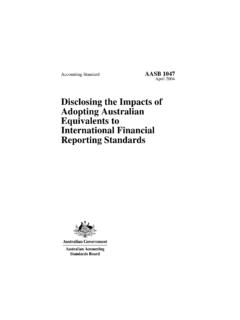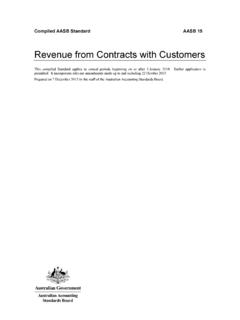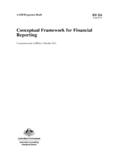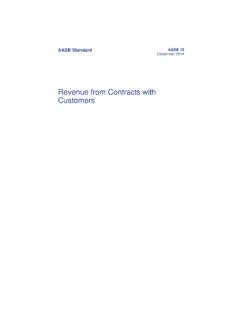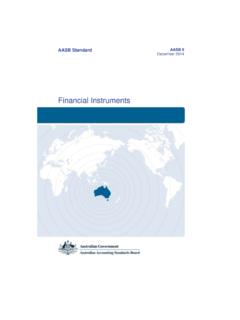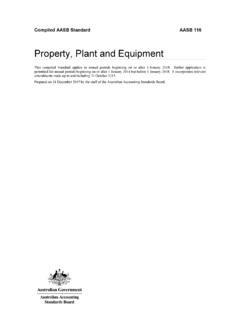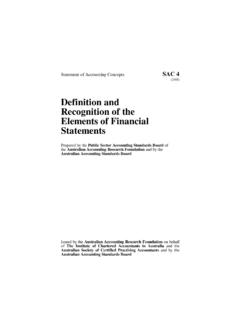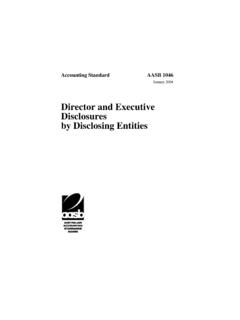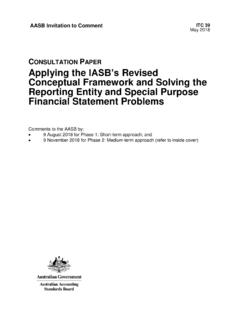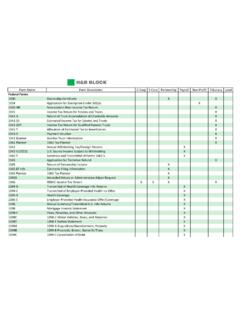Transcription of Accounting for the Goods and Services Tax (GST)
1 Urgent Issues Group Interpretation 1031 July 2004 Accounting for the Goods and Services Tax (GST) Obtaining a Copy of this Interpretation This Interpretation is available on the AASB website: Alternatively, printed copies of this Interpretation are available for purchase by contacting: The Customer Service Officer Australian Accounting Standards Board Level 3 530 Collins Street Melbourne Victoria 3000 AUSTRALIA Postal address: PO Box 204 Collins St West Melbourne Victoria 8007 AUSTRALIA Phone: (03) 9617 7637 Fax: (03) 9617 7608 E-mail: Website: Other enquiries: Phone: (03) 9617 7600 Fax: (03) 9617 7608 E-mail: COPYRIGHT 2004 Commonwealth of Australia This work is copyright.
2 Reproduction in unaltered form (retaining this notice) is permitted for personal and non-commercial use subject to the inclusion of an acknowledgment of the source. Apart from any use as permitted under the Copyright Act 1968, no part may be reproduced by any process without prior written permission from the Australian Accounting Standards Board. Requests and enquiries concerning reproduction and rights for commercial purposes should be addressed to The Administration Director, Australian Accounting Standards Board, PO Box 204, Collins Street West, Melbourne, Victoria 8007. ISSN 1449-8316 - 3 - PREFACE Main Features of this Interpretation This Interpretation is applicable to annual reporting periods beginning on or after 1 January 2005. Early adoption of this Interpretation is not permitted.
3 Application of this Interpretation will begin in the context of adopting all Australian equivalents to International Financial Reporting Standards. The requirements of Accounting Standard AASB 1 First-time Adoption of Australian Equivalents to International Financial Reporting Standards must be observed. AASB 1 requires prior period information , presented as comparative information , to be restated as if the requirements of this Interpretation had always applied. This differs from previous Australian requirements where changes in Accounting policies did not require the restatement of the income statement and balance sheet of the preceding period. The Interpretation requires revenues, expenses and assets (other than receivables) to be recognised net of the GST, except where the GST is not recoverable from the taxation authority.
4 Receivables and payables are to be recognised inclusive of the GST. The Interpretation also requires cash flows to be included in the cash flow statement on a gross basis. Comparison with Superseded Requirements There is no substantive difference with the previous requirements in Australia in the superseded UIG Abstract 31 Accounting for the Goods and Services Tax (GST). However, the requirements concerning the Accounting for costs incurred to update existing systems or create new systems have been deleted because they are now covered by Accounting Standards AASB 116 Property, Plant and Equipment and AASB 138 Intangible Assets. - 4 - URGENT ISSUES GROUP INTERPRETATION 1031 Accounting FOR THE Goods AND Services TAX (GST) ISSUE 1. Legislation to introduce the Goods and Services tax (GST) on 1 July 2000, titled A New Tax System ( Goods and Services Tax) Act 1999, was assented to on 8 July 1999.
5 The GST replaced the wholesale sales tax regime and a number of other taxes. 2. The GST legislation provides that the price quoted for the supply of Goods and Services and the price paid by the purchaser must include the amount of the GST where applicable. As such, the gross proceeds collected by the supplier includes the amount of GST. The GST is collected on behalf of the taxation authority. The purchaser of Goods and Services subject to the GST is, in many circumstances, able to obtain input tax credits for the GST included in the price of the Goods and Services acquired. Therefore, the price paid by the purchaser includes the GST that will be recovered from the taxation authority where an input tax credit can be claimed. 3. While authoritative requirements in Australia do not deal specifically with Accounting for the GST, Accounting Standard AASB 118 Revenue defines revenue, specifies revenue recognition criteria and states that amounts collected on behalf of third parties such as Goods and Services taxes are excluded from revenue.
6 Furthermore, AASB 102 Inventories provides that the cost of purchase of inventories does not include taxes that are subsequently recoverable from taxation authorities. 4. Concern has been expressed that, in the absence of authoritative guidance concerning Accounting for the GST in general purpose financial reports, diverse or unacceptable practice may occur or develop and that this will undermine the relevance and reliability of general purpose financial reports. 5. The issues are: (a) whether the GST should be recognised as part of the revenue of a supplier and as part of the cost of acquisition of assets and/or part of an item of expense of a purchaser; and - 5 - (b) whether amounts reported in the statement of cash flows should be reported on a gross basis. CONSENSUS 6. Revenues, expenses and assets shall be recognised net of the amount of Goods and Services tax (GST), except where paragraphs 7 and 8 apply.
7 7. The amount of GST incurred by a purchaser that is not recoverable from the taxation authority shall be recognised as part of the cost of acquisition of an asset or as part of an item of expense. 8. Receivables and payables shall be stated with the amount of GST included. 9. The net amount of GST recoverable from, or payable to, the taxation authority shall be included as part of receivables or payables in the balance sheet. 10. Cash flows shall be included in the cash flow statement on a gross basis, subject to paragraph 11 and to AASB 107 Cash Flow Statements. 11. The GST component of cash flows arising from investing and financing activities which is recoverable from, or payable to, the taxation authority shall be classified as operating cash flows. Application 12. This Interpretation applies to: (a) each entity that is required to prepare financial reports in accordance with Part of the Corporations Act 2001 and that is a reporting entity; (b) general purpose financial reports of each other reporting entity; and (c) financial reports that are, or are held out to be, general purpose financial reports.
8 13. The requirements of this Interpretation regarding cash flow statements also apply to each non-reporting entity that is required - 6 - to prepare financial reports in accordance with Part of the Corporations Act. 14. This Interpretation applies to annual reporting periods beginning on or after 1 January 2005. 15. This Interpretation shall not be applied to annual reporting periods beginning before 1 January 2005. 16. The requirements specified in this Interpretation apply to the financial report where information resulting from their application is material in accordance with AASB 1031 Materiality. 17. When applicable, this Interpretation supersedes Abstract 31 Accounting for the Goods and Services Tax (GST), as issued in January 2000. 18. Abstract 31 remains applicable until superseded by this Interpretation.
9 DISCUSSION 19. The GST is a tax on the supply of Goods and Services which is ultimately borne by the final consumer but is collected at each stage of the production and distribution chain. The terms taxable supply , input taxed , input tax credit , GST-free and registered entity have the same meaning as in A New Tax System ( Goods and Services Tax) Act 1999. 20. AASB 118, paragraph 7, defines revenues as inflows of economic benefits during the period arising in the course of the ordinary activities of an entity when those inflows result in increases in equity, other than increases relating to contributions from equity participants. The GST component of the transaction price does not constitute revenue of the vendor. This is because the transaction gives rise to a present obligation to remit the amounts of the tax collected to the taxation authority.
10 This is reflected in AASB 118, paragraph 8, which states that amounts collected on behalf of third parties such as sales taxes, Goods and Services taxes and value added taxes are not economic benefits which flow to the entity and do not result in increases in equity. 21. Where an entity undertakes taxable and GST-free activities, it is entitled to claim input tax credits and recover from the taxation authority the GST included in the purchase price of supplies. This Interpretation reflects the view that in these cases the GST is not part - 7 - of the cost of the asset acquired or the expense incurred. This is consistent with the Framework for the Preparation and Presentation of Financial Statements, which states that expenses are recognised in the income statement when a decrease in future economic benefits related to a decrease in an asset or an increase of a liability has arisen that can be measured reliably.
